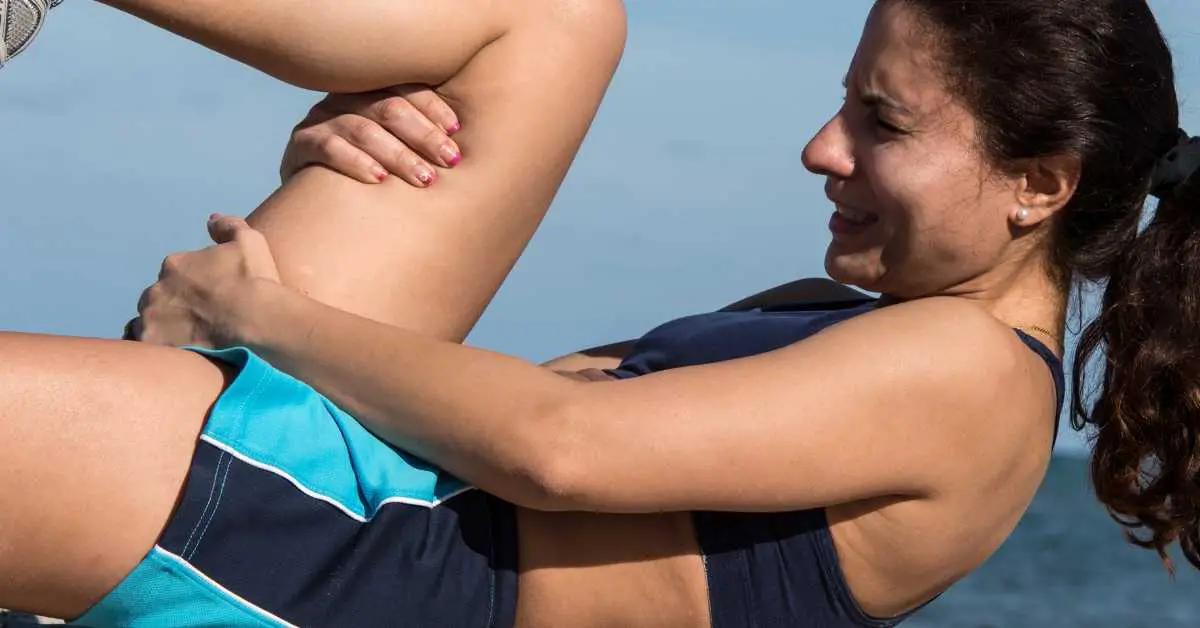Running might be one of the most popular workouts out there, but let’s face it—it’s brutal. It’s tough, demanding, and often ditched at the first sign of discomfort.
Sore back? Tight hips? Aching everywhere?
Welcome to the club. Sure, massages sound like the perfect fix—great for easing soreness and bouncing back after a punishing run—but who’s shelling out big bucks for a stranger to knead their muscles? The good news? You don’t have to. There are smarter, cheaper ways to crush your runs without letting pain or pricey therapy sessions hold you back. Let’s get into it.
The Importance of Massage After Running – The Why
Massage Recovery – Why It’s Important
Massage recovery is a luxury not everyone can afford, but it’s important to your health and well-being.
Whether you are preparing for a marathon or in the middle of your 10k training program, muscle soreness or delayed onset muscle soreness (DOMS) can quickly derail any training program.
Massage is one of the best ways to recover from a hard workout or long day of work. It relieves tension and soreness in your muscles, while also helping you relax and unwind.
You deserve to treat yourself! Massage can help you feel better after a stressful day at work or an intense workout.
Here are some reasons why you should consider getting a massage:
- Ease muscle tension
- Reduce muscle inflamation
- Relieve stress
- Improve sleep quality
- Reduce pain
- Aid in injury rehabilitation
Benefits of Massage After Running
Whether you’re a seasoned runner or just starting out, massage can help you recover from the wear and tear of running.
Running is a great way to get in shape, but it can leave your body feeling sore, tired, and stiff. Massage can help you relax after a long run and relieve tension in your muscles.
Massage also helps to clear lactic acid from your muscles so that they don’t feel as stiff or sore. Lactic acid builds up when you exercise and causes pain in your muscles. Massage helps to it break down so it can be removed by the body more quickly.
Massage also helps improve blood circulation, which reduces swelling and inflammation caused by intense training. This means that you’ll maintain mobility, and recover faster after a tough workout or race!
Be sure to see my complete breakdown of top-rated massage chairs — including models best suited for arthritis, back pain, and hip stiffness — don’t miss our expert buying guide: Best Massage Chairs for the Money! Discover real therapeutic features, verified user feedback, and manufacturer specs that matter most for pain relief.
Best Massage for Runners
Pre-run massage
If you’re a runner, you already know that your body needs some TLC before you hit the pavement.
But did you know that there are specific massage techniques that can help you run faster and for longer?
Here are five of the best massage techniques for pre-run:
1. The Fascial Stretch
Fascial stretch is a type of massage that focuses on the connective tissues in your body. This includes ligaments, tendons, and joint capsules. The purpose of the fascial stretch is to increase mobility and prevent injury. While it may not be as relaxing as other types of massage, this technique will leave you feeling loose and limber before your next run.
2. Deep Tissue Therapy
Deep tissue massages focus on working out deep layers of muscle tension and knots that might be causing pain in certain areas of your body. Deep tissue massage works wonders for runners who experience tightness or pain in their hamstrings or calves after training sessions or races. If you’re experiencing this kind of tightness or pain during exercise, consider booking a session to see how it can impact your performance.
3. Trigger Point Therapy
Trigger point therapy is a form of deep tissue massage that focuses on specific tight spots in your muscles. These tight spots are often referred to as “trigger points,” and they can be difficult to work out on your own. In fact, you may have tried everything from foam rolling to stretching without finding relief for these painful areas. If so, then trigger point therapy might be the perfect solution for you!
4. Myofascial Release
For those who aren’t sure what this means: Myofascial release (MFR) refers to a type of soft tissue bodywork that aims to treat muscular pain by releasing fascia (connective tissue). The idea behind MFR is that fascia can be restricted when it becomes adhered to the muscle tissue. This can cause pain, numbness, or other symptoms of discomfort. By using gentle pressure and slow strokes, an MFR therapist helps release these adhesions so that your muscles can function more efficiently.
5. Neuromuscular Therapy
This massage technique aims to treat muscular soreness by focusing on both the fascia and the nervous system, which control the way your muscles work. As such, it’s often used in conjunction with trigger point therapy or myofascial release in order to address chronic pain problems.
Be sure to read my recent post on the 10 benefits of sports massage.
Post-run recovery
After a long run, your body needs to recover. And we’re not talking about the kind of recovery that involves a nap and a sandwich. We’re talking about deep-tissue massage.
It’s no secret that running is one of the best ways to keep your body healthy. It can help you lose weight, lower your blood pressure and cholesterol levels, build lean muscle tissue, improve your cardiovascular system, and even increase your lifespan!
But what happens when you run?
You may end up with tight muscles and sore joints. That’s where massage comes in. Massage can help loosen up those stiff muscles so they can repair themselves faster than if they were left alone—and it can also help alleviate any pain or discomfort that might be keeping you from returning to normal activity levels too fast after activity (which could lead to further injury).
It’s also great for relieving stress, which can often feel like a big problem when you’ve just gotten back from an intense run!
A good massage should last at least 45 minutes—long enough for the therapist to get deep into the tissue beneath your skin layers—and should include techniques like deep tissue massage, trigger point therapy (which focuses on specific points in your muscles that are known to cause pain and discomfort), Swedish massage (which focuses on the whole body, with long strokes), and myofascial release (a technique that stretches your fascia).
It’s important to reduce lactic acid build-up and stimulate blood flow to jump-start your recovery process.
There’s no one-size-fits-all when it comes to finding a good massage therapist. The best way to determine what kind of massage therapy is right for you is to ask your therapist questions about the different techniques they use. It’s also important that your prospective masseuses have extensive experience with athletes and sports-related issues.
Self-Massage After Running
Self-massage is the best way to recover after a run.
Running is great for your body, but it can leave you feeling sore and stiff.
There are two main benefits that come from self-massage: it increases circulation and releases endorphins to help your body relax.
Self-massage is also easy to do at home and doesn’t require any special equipment. You can use a foam roller, tennis ball, or lacrosse ball—whatever works best for you!
Are Massage Guns Good for Runners
Yes. Massage guns are great for runners!
You might not think that a gun-shaped device that uses vibration to break up knots and trigger points in your muscles would be helpful to runners, but it actually can be incredibly beneficial.
The reason massage guns are so great for runners is that they allow you to get a deep tissue massage while being able to move around and keep your muscles flexible.
This is important because one of the biggest problems facing runners is tightness in their legs and hips. When you’re running all day long, your muscles become sore and stiff, which can lead to injury if not treated right away.
But with a massage gun, you can get a deep tissue massage without having to stop moving around. This allows you to keep your muscles loose enough so that they don’t overwork themselves during a run or after one has ended—which will help prevent injuries from occurring in the future as well!
How Does Massage Help Muscles Recovery?
Regular massage therapy helps muscles recover because it promotes blood flow and circulation. When you exercise, you break down the muscle fibers, which means that the body needs to repair them. Massage helps to increase the amount of blood flowing to the area so that the body can speed up its natural healing process.
Massage also increases muscle flexibility and range of motion. This is because it increases blood flow and circulation, which in turn increases nutrients and oxygen to the muscles—which is what they need to be flexible!
Effects of Massage for Sports Recovery
Massage is a popular way to help with sports recovery. In fact, it is the most used recovery method for professional athletes, regardless of their sport.
There are many different kinds of massage, and they differ in their focus and purpose.
For example, Swedish massage aims to relax the body and relieve tension. While deep tissue massage focuses on specific areas of the body, like the back or legs, to release muscle tension and help improve circulation.
Yes, many professional athletes swear by massage for helping them recover from injury and soreness after strenuous activity.
Sore muscles can be caused by overuse or injury, which can have a negative effect on performance. Massage helps reduce pain and inflammation, as well as improve circulation in the affected area.
It is also thought that regular massages may improve flexibility, which could improve athletic performance.

Claudia Faucher is a full-time fitness training expert and lifestyle blogger. She is also been a certified Les Mills BodyPump instructor for the past 5 years and a fitness instructor for over 20 years. Claudia is a personal trainer and creates fitness training programs for seniors and people of all ages. She likes to use her skills and experiences to help others on their fitness journeys.
